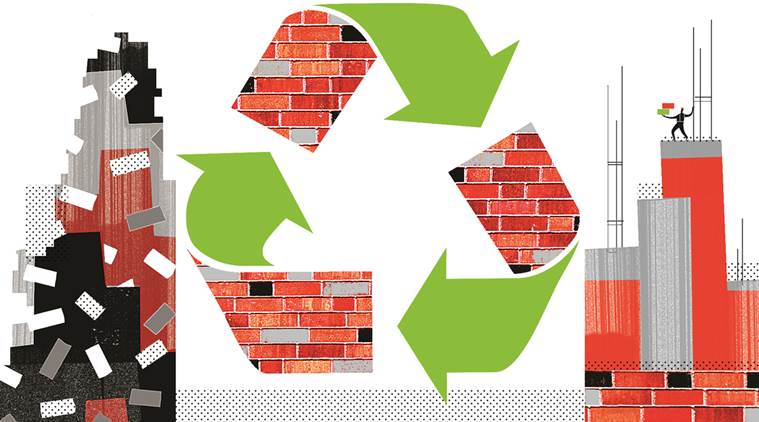Building from debris
Construction and demolition waste is an environment and public health hazard. Its recycle and reuse offers a sustainable solution

The Ministry of Environment, Forests and Climate Change in 2010, put the annual estimate of C&D waste at 10-12 million tonnes. (Illustration by: C R Sasikumar)
India is urbanising faster than its urban planners can handle. We are building roads, bridges, fly-overs, factories, commercial complexes and also building and renovating our homes and residential properties (sometimes to upgrade the buildings or to take advantage of higher FSI regulations now allowed in many cities). But we do not pay sufficient heed to the construction and demolition (C&D) waste we generate, for example, bricks, concrete, stones, hard core subsoil, topsoil, timber, glass, gypsum, ceramics and also plastics. Neglecting this waste has consequences for public health as well as the environment.
There is no agreement on the volume of C&D waste. The Ministry of Environment, Forests and Climate Change in 2010, put the annual estimate of C&D waste at 10-12 million tonnes. The Central Pollution Control Board settled for 12 million tonnes in 2011, but its Guidelines Document of 2017 has upped the estimate to 25-30 million tonnes, based on information from the Ministry of Urban Development. The Centre for Science and Environment, swung to the other extreme and estimated C&D waste at a humongous 530 million tonnes for 2013, as they include the waste from renovations/repairs, assuming that one-third of the existing stock of buildings carried out renovations/repairs in 2013.
The most recent annual estimate of C&D waste in Indian cities is 165-175 million tonnes, jointly prepared for the period 2005 to 2013, by two government agencies, the Building Materials and Technology Promotion Council, and the Centre for Fly Ash Research and Management. This waste is dumped illegally on vacant sites, on the sides of highways, below fly-overs, beside lakes and rivers, in other low-lying areas and open stormwater drains. Delhi and Bengaluru provide glaring examples of this practice, commonly known as “fly-tipping”. In Bengaluru, C&D waste is increasingly being used to encroach on lake-bed land for construction.
Delhi’s air pollution is in no small measure due to the high presence of particulate matter (PM 2.5 and PM 10), resulting from the construction debris strewn around the city. Waterlogging, with all its adverse impact on public health and the environment, is another consequence as the runoff from smooth surfaces is trapped in the debris.
Other countries have faced similar challenges and have done something about it. Germany faced huge issues in disposing of the post-war bomb rubble. Stuttgart solved this problem by creating a mini-hillock outside the town which is now a recreational hand-gliding spot. While C&D waste was earlier typically sent to dump sites in many countries, in the past 20 years or so there has been a greater appreciation of the reuse and recycling possibilities of the waste into construction material (recycled aggregate concrete, manufactured sand, etc.) and its implication for the conservation of natural resources.
An EU study has calculated that an average of 28 per cent of all C&D waste was recycled in EU countries in the late 1990s. Since then, most EU members have set goals for recycling C&D waste that range from 50 per cent to 90 per cent of their C&D waste production. The UK’s use of recycled aggregates (materials formed from a mass of fragments or particles loosely compacted together) is the highest in Europe and accounts for 25 per cent of all aggregates used in construction. This has created a vibrant recycling industry, which promotes innovation and new products and their uses, while the International Recycling Federation works to harmonise quality standards for recycled materials.
Even in the US which is known for its proliferation of landfills, California, the most progressive state, has promulgated an ordinance which requires 50 per cent recycling of C&D waste and 75 per cent diversion of inerts away from landfills.
Closer home, Singapore was recycling 98 per cent of its construction waste by 2007. Hong Kong has been recycling its waste to produce recycled aggregates (RA) for use in government projects and R&D work. In Taiwan, a comprehensive plan for the management of C&D waste was put in place in 1999 as a response to the challenge posed by the severe earthquake that year, which damaged about 100,000 dwellings.
India’s record, by comparison, is very poor. Until two years ago, C&D waste was not even looked at separately from the municipal solid waste (MSW). The Municipal Solid Waste (Management and Handling) Rules, 2000, merely stated that C&D waste be “separately collected and disposed of in accordance with State laws”. Only there were hardly any state laws! But in 2016, recognising the importance of growing volumes of C&D waste in urban areas and the significant differences in the origin and quality of this waste and in the methods of its recycling and reuse, the Construction and Demolition Waste Management Rules 2016 were separately notified by the Ministry of Environment, Forests and Climate Change, and the Solid Waste Management Rules (2016) superseded the 2000 Rules. This reflected the growing recognition of the need to manage C&D waste separately from the municipal solid waste.
The presence of C&D waste in the mixed waste reduces the effectiveness of composting or biomethanation and also reduces the calorific value and combustibility of the MSW. The presence of MSW in debris similarly reduces the quality of recycled C&D waste. While builders and renovators must keep C&D waste unmixed, urban local bodies must ensure that the Rules are enforced. For example, the Rules specify that all government construction projects, at all levels, should utilise between 10 and 20 per cent of C&D recycled products (aggregates, kerb stones, paver blocks, tiles and manufactured sand). This has not happened despite the orders of the National Green Tribunal and other regulatory bodies.
In Delhi itself, which has three C&D waste recycling plants set up by IL&FS Environment, at Burari (2000 TPD capacity), Shastri Park (500 TPD capacity) and Mundka (150 TPD capacity), the government projects have used only 200,000 tonnes of recycled material per annum even as the C&D waste generated has reached 1.5 million tonnes per annum.
The C&D waste recycling industry is in a very nascent stage in India. The challenge is to ensure that C&D waste comes to the recycling plants as segregated input, and the recycled products are picked up for use in construction. The government has to build awareness of the value of recycled products and also provide standard codes to ensure adherence to quality. The government also has to set an example in its own construction activity by complying with the Rules. At the same time, the incentives also have to be aligned for the private sector, for example, the imposition of a reasonable charge for disposal at dumpsites can induce builders or owners to divert the C&D waste to recycling plants. An important additional step in this direction would be to reduce GST rates on products using recycled materials.
Last but not least, effective management of C&D waste helps in curbing excessive consumption of natural resources and contributes to sustainable development. For example, the demand for sand is expected to more than double between 2010 and 2020. In India, we primarily use river sand for construction. The Supreme Court has recently warned about the adverse environmental consequences of riparian sand mining. Increasing demand, easy availability and limited government oversight have given rise to a thriving illegal trade in sand. Manufactured sand from C&D waste provides an environmentally sustainable alternative.
Since almost 60 per cent of the stock of buildings projected to be there in 2030 is yet to be built, sustainable construction and effective management of C&D waste assume even greater significance.
Ahluwalia is chairperson, ICRIER, Delhi, and former chairperson of the high-powered expert committee on urban infrastructure and services. Patel is member, Supreme Court committee on solid waste management
For all the latest Opinion News, download Indian Express App
More From Isher Judge Ahluwalia
- Cities at crossroads: No more cover-upsMunicipal authorities are opting for capping as a solution to the problem of mixed waste at dumpsites. Bio-remediation and bio-mining may be more desirable...
- Cities At Crossroads: Managing the run-offAn IIT Delhi report offers important pointers on how to ensure a smooth drainage system in the capital using its natural waterways...
- Ripples of reform in DhakaBangladesh capital’s transformation of the water services sector, that connects the urban poor to the piped network, has lessons for cities in India..







































No hay comentarios:
Publicar un comentario